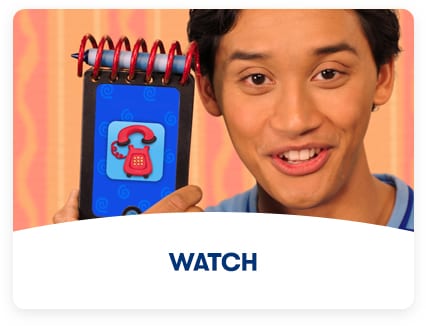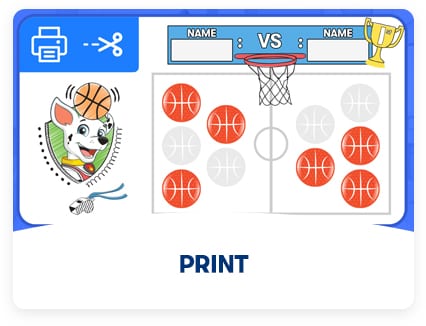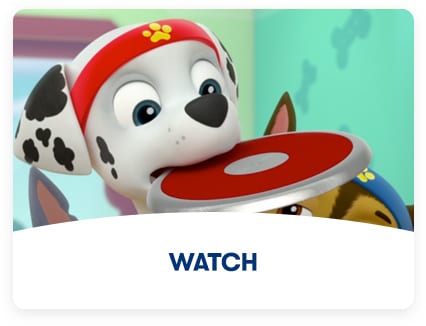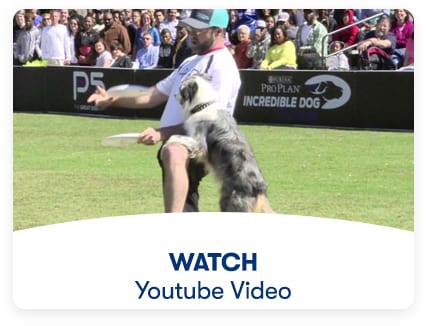💡Skill: Telling stories builds language skills and brings parents and children closer together!
Make up a story together about someone who’s a hero in your community.
Steps
- Let’s make up our own story about a hero in our community! Our hero can be a doctor, police officer, grocery store worker, delivery worker, or anybody else in our community who helps others.
- I’ll start: Once upon a time, there was a community hero, who….
- Now it’s your turn to add some details: Where does she live? Who’s in her family? What is her special talent? What happens to the hero first … next … and last?
- Let’s keep taking turns and adding to the story. We can even take a break and start the story again tomorrow!
Bubble Guppies Firefighters StoryPosted by NOGGIN on Saturday, April 11, 2020
Dive into a fire-fighting adventure with the Bubble Guppies!

💡Skill: Doing jumping jacks helps your child build muscles and get his or her body ready for the day, and counting the jumping jacks builds math skills!
How many jumping jacks can we do in 1 minute?
Steps
- Let’s get our hearts pumping and bodies moving! Stand with your feet together and your hands together over your head.
- Now jump and land so your feet are apart and your hands are in a Y shape over your head.
- Jump back in and out. You’re doing jumping jacks! How many can we do in one minute?
- Ready…Set…Jump!
Jumping Jacks with Wally & Norville!Posted by NOGGIN on Saturday, April 11, 2020
Jump into this challenge with Wally and Norville!











🔅 Recommended Daytime Activity


How do Josh and Blue receive calls from Steve and Joe? Here’s a clue… Alexander Graham Bell invented the telephone 144 years ago to help people talk to each other. The telephone changed the way people communicate. Thanks for doing your part, you sure are smart, Mr. Bell!
Description
Look at Blue’s friend using a rotary phone in the picture above! This is a phone that people used before cell phones. It has a circle with holes for your fingers- when you turn the circle, it dials the number! Let’s use our phone to make “kindness calls” to cheer up someone we love!
Materials
☑ Printable (optional)
Set Up
Here’s how to explain this activity to your child:
- Alexander Graham Bell invented the telephone to help people talk to each other. Let’s use OUR modern-day phone to make “kindness calls” to someone we care about.
- Let’s think of 3 things to talk about. We could ask questions or talk about new books we’ve read or tell funny jokes.
- Let’s make our first kindness call. Who should we call — a grandparent? A friend?
- Isn’t it amazing that our voices can travel from here to there?
Extend the Learning
Let’s play a game of telephone! Print easy-reader cards for kids and get inspired by watching these Blue’s Clues videos.
Words to Use
- Kindness– friendly, nice
- Travel – make a journey
- Telephone – a system for transmitting voices over a distance using wire or radio
- Communicate – share information
Simplify
Let’s pretend to call each other — using bananas or toy phones — and talk with each other to make each other smile.
Stretch
Before we have our first kindness call, let’s write down 3 words or pictures to help us remember what we want to say. Let’s try to make one kindness call every day this week to someone we care about.
Why?
- Reaching out and talking to someone builds language and communication skills
- Listening builds empathy — understanding others’ feelings.











🔅 Recommended Daytime Activity


Turning Two Things into One New Thing: A lot of inventions combine two everyday things into one new thing. When Earle Dickson created the Band Aid, he did that. He combined surgical adhesive tape and gauze to create the first Band Aid — which a person who was hurt could put on by himself or herself to feel better.
Description
Earle Dickson’s wife Josephine always got little cuts and burns when she was cooking. Earle invented the Band Aid 100 years ago in 1920 to help his wife. Let’s think of ways that we could use supplies we have at home to help our stuffed animals — just like the Bubble Guppies helped sick jungle animals!
Materials
☑ A doll or stuffed animal
☑ Supplies from around home to make a band aid, like tissue, toilet paper, or fabric and tape
☑ Printable (optional)
Set Up
Here’s how to explain this activity to your child:
- Earle Dickson invented the Band Aid 100 years ago to help his wife, who was always getting little cuts and burns when she was cooking. Band Aids were so easy to use that she could patch up her own boo-boos!
- Let’s make our own band aids to help our stuffed animals or dolls — just like the Bubble Guppies helped sick jungle animals. We can use a piece of tissue, toilet paper, or fabric and some tape to help it stick.
- Now let’s pretend to help one of our stuffed animals or dolls. Let’s ask what’s wrong and how our animal or doll feels. Then, let’s pretend to help them. Let’s clean the cut and then cover it with a band aid. Does our friend feel better?
Extend the Learning
Let the Bubble Guppies and our printable nurse hat inspire your pretend play session. And consider reading “Rosie Revere, Engineer” by Andrea Beaty and illustrated by David Roberts (or watch Astronaut Kate Rubins read it to you from the International Space Station thanks to Story Time From Space).
Words to Use
- Nurse – someone who takes care of people who are sick or hurt
- Injure – hurt
- Pretend – to act something out
- Band Aid – a bandage that covers up a cut; an adhesive bandage with a gauze pad in the middle to cover the wound
Simplify
Make a band aid together and put it on a doll or stuffed animal. Talk to the animal about how he or she is feeling.
Stretch
Create a pretend animal hospital and care for all the animals who visit the hospital.
Why?
- Pretend play builds children’s imaginations.
- Pretending to help others builds empathy and expressive language skills.
Conversation Starter
Try asking these questions at lunchtime or dinnertime:
What are some things from around home that we could combine to create something brand new — like a flashlight and a paper cutout could create a shadow projector … or a shoebox and some rubber bands could create a string instrument.











🔅 Recommended Daytime Activity


Ninety years ago, Maria Telkes was fascinated with the Sun. She figured out how to use the Sun’s heat to warm up a whole house! Later, she invented a machine that could use the Sun’s power to turn saltwater into fresh (non-salty) water that we can drink.
Description
If you’ve seen Blaze help Darrington launch to the moon, you’ll know that the power of the Sun helped them get there. Let’s do a super solar power experiment! Let’s learn about how the Sun can turn saltwater into freshwater.
Materials
☑ Bowl
☑ Salt
☑ Water
☑ Drinking glass
☑ Plastic wrap
☑ Something heavy (like a small rock)
Set Up
Here’s how to explain this activity to your child:
- Scientist Maria Telkes was fascinated with the big star at the center of the solar system. Ninety years ago, she invented a way to use the Sun’s power to take the salt out of seawater so people could drink it. Let’s try it!
- First, let’s fill a bowl half way with water and then mix in a few spoonfuls of salt to make salt water. Now, let’s put a drinking glass inside of the bowl (making sure that the salt water doesn’t go into the glass).
- Then let’s stretch plastic wrap over the top of the bowl and put a rock on top of the plastic wrap right over the cup. Let’s put it in a sunny window.
- What do you think will happen? Let’s watch and see!
Extend the Learning
Watch Darrington and Blaze speed off to this solar-powered song during their mission to the moon!
Words to Use
- Sun – the star at the center of the solar system, which gives the Earth light and heat
- Solar – related to the Sun
- Salt– a white crystal that gives seawater its taste and is used for seasoning or preserving food
- Seawater – water that has salt in it, like in the ocean
- Experiment – to try something
Simplify
Do a simpler experiment to learn about the Sun’s power. Put a glass or jar with some water in it in the window. Mark how high the water is. Check again tomorrow and the next day. Does the water level change? Talk about how the Sun has the power to turn water into gas — which then floats out of the cup!
Stretch
Create an observation journal to track what happens to the experiment over time. Sample the water in the cup at the end. Does it taste salty at all? See if your child can explain what happened!
Why?
This experiment helps your inventor learn math, problem solving, and observation skills. Every time your inventor asks “WHY?” he or she is learning!
Conversation Starter
Try asking these questions at lunchtime or dinnertime:
Tell me the funniest/weirdest/silliest thing you learned recently!











🔅 Recommended Daytime Activity
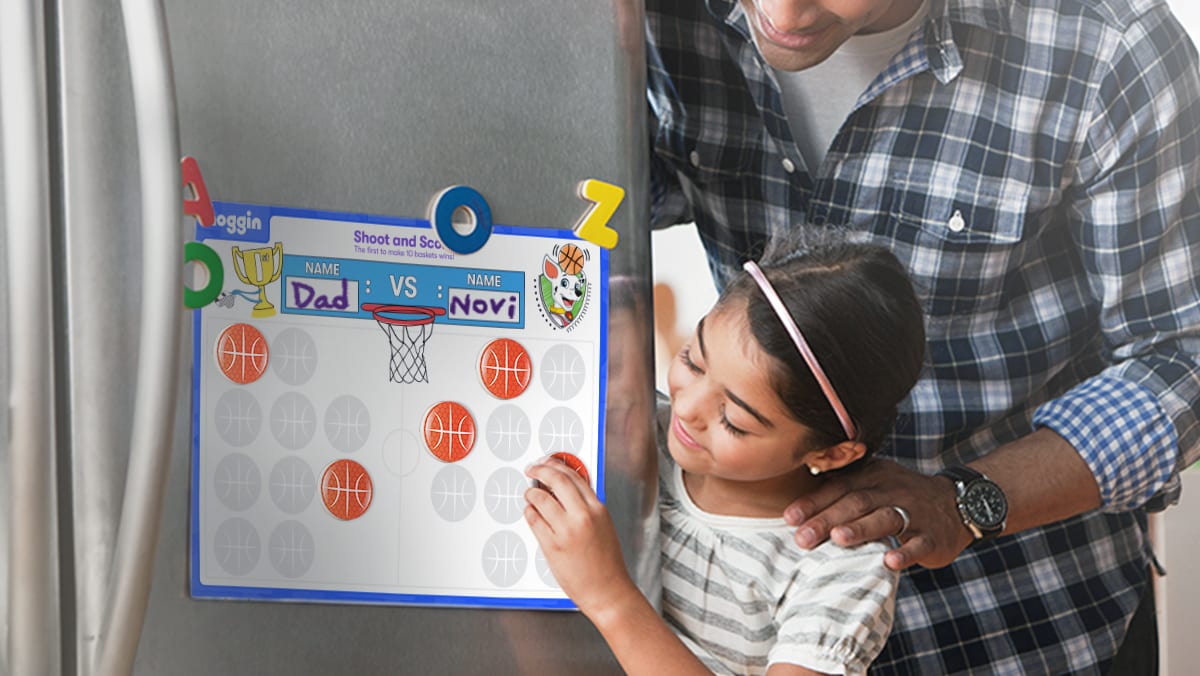

James Naismith was a physical education teacher. One cold winter, he was asked to create a game that his students could play indoors … and he invented basketball! The first baskets were peach baskets that did not have a hole in the bottom; when someone got the ball into the basket, they had to use a ladder to climb up and get the ball out of the basket to keep playing! Each team had 9 players not 5 like we do now. “The invention of basketball was not an accident. It was developed to meet a need.” — James Naismith
Description
James Naismith invented the PAW-fect indoor game — basketball, and now you and your little inventor can create your OWN version of this game! Let’s play indoor “box-it” ball!
Materials
☑ A box (a cardboard box or any other container you have at home)
☑ A soft ball
☑ Printable (optional)
Set Up
Here’s how to explain this activity to your child:
- James Naismith invented the PAW-fect indoor game: basketball! He’s the one who inspired Skye’s skyhook, Rocky’s spin and shoot, and Marshall’s Dalmation Dunk! Let’s create our own indoor basketball game — box-it ball — inspired by this incredible inventor.
- First, let’s find a box and a soft ball that is small enough to fit inside the box. If we don’t have a ball, we can put one sock inside of another to create our own ball.
- Now, let’s stand facing the box and take three steps back. How many times can we shot our ball into the box from here? Let’s take another step back. How many baskets can we make from here?
- Now, let’s create our own rules for our indoor “box-it” ball game!
Extend the Learning
Warm-up by watching the pups practice for a big basketball game, print a scoreboard for your refrigerator, and learn a few jokes that’ll cause the competition to giggle.
Words to Use
- Basketball – a ball that is thrown into a basket in a game called basketball
- Invent – to come up with a new idea
- Indoor – inside, not outside
- Inspire – to fill someone with the urge or ability to do or feel something
- Shooting – throwing a ball into a basket, like in the game of basketball
Simplify
Stand next to the basket and throw the ball into the box together. How many times can you get the ball into the box?
Stretch
Make the game more challenging. Move farther away from the box or try putting the box higher up (like on a chair or on a counter). If each time you get the ball in, you make 2 points, how many points do you make?
Why?
- Counting helps your little inventor understand that numbers go in order.
- Playing basketball builds coordination and strong muscles!
Conversation Starter
Try asking these questions at lunchtime or dinnertime:
What will YOU invent? What will it do? What problem will it solve?











🔅 Recommended Daytime Activity


In 1937, Walter Fredrick Morrison started throwing a popcorn can lid back and forth with his girlfriend at a picnic … and it was fun! This inspired him to invent the Frisbee (initially called the Pluto Platter, the Flyin’ Cake Pan, the Whirlo-Way, and the Flyin-Saucer). This invention was based on a long history of humans throwing frisbee-shaped disks. Thousands of years ago in 708 BC, the discus was introduced as part of the pentathlon in the Ancient Olympics in Greece! Morrison reportedly never really liked the name “Frisbee” for his invention — but that didn’t stop it from becoming a widely popular toy!
Description
Walter Fredrick Morrison’s inspiration for the Frisbee came from a popcorn can lid. What can you and your little inventor use to build your own Frisbee? Let’s see what you can find in the house that flies like a frisbee!”
Materials
☑ A lid like an oatmeal container lid or a paper plate (or circle cut out of cardboard)
☑ Scissors
☑ Crayons/ markers (optional)
Set Up
Here’s how to explain this activity to your child:
- Walter Fredrick Morrison got the idea to invent the frisbee after throwing around a popcorn can lid with his girlfriend. He ended up creating a frisbee — which has provided hours of fun for people and dogs, including the PAW Patrol pups.
- Let’s try creating our own frisbee together! We can either use a lid like an oatmeal container lid or we can create our own frisbee with a paper plate! Or we can create our own with a paper plate. First, let’s trace and then work together to cut out a small circle inside a paper plate so we have a ring of paper. (If we don’t have paper plates, we can create a ring out of cardboard.) Let’s decorate!
- Now, let’s stand about 5 feet apart from one another and throw the frisbee back and forth 3 times. Let’s flick our wrists as we throw.
- Let’s invent the rules for our own indoor frisbee game! Every time we throw it, we have to jump. What other rules should we add to our game?
Extend the Learning
Some dogs are amazing frisbee catchers. Watch the PAW Patrol pups and real-life dogs show off their frisbee skills!
Words to Use
- Frisbee – a plastic disk that can fly through the air
- Invent – to come up with a new idea
- Flick – a quick movement
Simplify
Stand together and see how far you can throw the frisbee across the room.
Stretch
Stand farther and farther apart and see how many times you can successfully throw and catch the frisbee.
Why?
Playing with frisbees builds kids’ hand and wrist muscles and coordination.
Conversation Starter
Try asking these questions at lunchtime or dinnertime:
This is a plastic lid, but what could it become? What are the silliest, craziest inventions we can imagine?











🔅 Recommended Daytime Activity


Thousands of years ago, ice cream was only for kings and queens; people would gather ice from the mountains and mix it with honey and fruits. Nancy Johnson invented the ice cream churn, which made ice cream a treat for everyone — from me and you to Team Umizoomi who sing a catchy song about how much they love ice cream!
Description
Let’s pretend to make our own ice cream shop and then, if we have the ingredients, let’s try making our own ice cream.
Materials
☑ Paper
☑ Crayons
☑ Printable (optional)
Set Up
Here’s how to explain this activity to your child:
- Team Umizoomi sings about all of the delicious shapes of ice cream. Do YOU love ice cream?
- Let’s pretend we’re opening our own ice cream shop. How many flavors will we offer? What are our shop’s special flavors?
- Let’s create a sign for our shop, listing all the flavors with pictures and words. What is our shop’s name?
- Can you help me pick a flavor? Let’s switch roles.
Extend the Learning
I dream, you dream, we all dream of ice cream! Print and play with our ice cream stacking game, get an easy recipe for making ice cream at home, and sing a sweet ice cream song along with Team Umizoomi.
Words to Use
- Ice Cream – a creamy, frozen food made with milk/cream and sugar
- Shop – a store
- Flavor – what something tastes like
- Shake – to move up and down or side to side with fast, strong, jerky movements
- Ingredients – the foods that you put together to make a dish
Simplify
Create an ice cream cone out of paper. Talk about the kinds of ice cream you love the most.
Stretch
See if your child can come up with at least three silly ice cream flavors — pickle, potato, pine tree, etc. Make up a story together about an ice cream store that sells silly ice cream flavors.
Why?
Pretending helps kids develop language skills and grow into great storytellers.
Conversation Starter
Try asking these questions at lunchtime or dinnertime:
What’s your favorite ice cream flavor? Now, let’s imagine some crazy ice cream flavors: pickle ice cream … cheddar cheese ice cream? Which crazy ice cream would you want to try?
30 Days Free | Cancel Anytime Start Your FREE Trial













Did you know:
Original maracas were made out of dried gourds — a fruit with a hard skin — filled with seeds.
Maracas are usually played in pairs — with one in each hand.
Maracas are part of the rattle family. Rattles are ancient instruments that have existed as far back as ancient Egypt!
Description
Many people think the Taino Tribe of Puerto Rico invented maracas — the musical instrument that, according to Blue and Steve, makes a “shake, shake” sound. Maracas are fun to shake and equally fun to make. Let’s get shaking and making maracas!
Materials
☑ 2 empty toilet paper rolls or empty plastic bottles
☑ Paper
☑ Tape
☑ Beads or dried pasta or beans
☑ Decorations
Set Up
Here’s how to explain this activity to your child:
- The Taino Tribe of Puerto Rico is believed to have invented maracas — instruments that make sound when you shake them and that inspire Blue and Steve to “shake, shake!” Let’s make our own instruments inspired by these amazing, musical inventors.
- Let’s use paper and tape to cover one end of two empty toilet paper or paper towel tubes. Now let’s fill one tube with one handful of dried beans/pasta/beads and let’s fill the other with a few handfuls and seal the other side with paper and tape. [You can use other materials that you have at home like empty water bottles or dry rice! Be creative!]
- Let’s shake, shake, shake! We’re making music.
- What do you hear? Is one maraca louder than the other? Let’s listen to the different sounds and rhythms we can create. Let’s dance to our maraca music!
Extend the Learning
Does your little musician hear music everywhere? Watch Steve’s friends make maracas, print an activity kit and more from wyntonmarsalis.org, and play a listening game with Blue and Steve!
Words to Use
- Maracas – an instrument that makes music when you shake it
- Instrument – something that makes music
- Hear – one of the five senses; we use our ears to hear
- Ear – the part of our body that helps us hear
- Shake – to move back and forth quickly
Simplify
Make one maraca. Ask your little musician to shake it up and down and side to side to make music.
Stretch
Work with your child to make a maraca band. Fill each maraca with different things — from dry beans to dry rice to paper clips. Compare the different sounds!
Why?
When kids make music, they’re developing their sense of hearing and their understanding of the world that surrounds them.
Conversation Starter
Try asking these questions at lunchtime or dinnertime:
Percussion instruments like rattles or drums make noise when you shake, strike, or scrape them! Can we think of five things from around home that we could turn into percussion instruments?











💡Skill: Taking deep breaths relaxes the muscles in your body and helps you take care of yourself!
Description
Practice breathing to relax when you feel stressed, angry, or sad!
Extend the Learning
Sometimes everyone needs to take a break. Take care of yourself by practicing breathing with Goby and learn how to calm your body and mind!
Words to Use
Breathe – to move air into and out of your body
Calm – very still
Relaxed – to become less tense/anxious
Stressed – very worried











